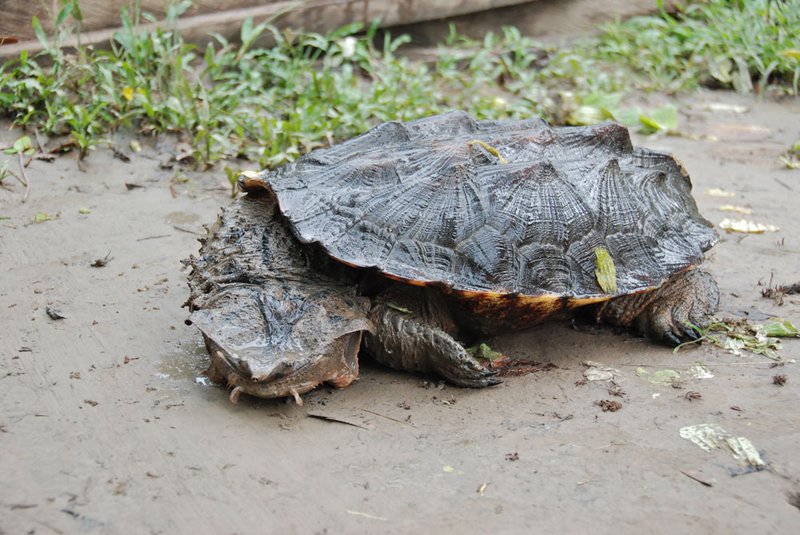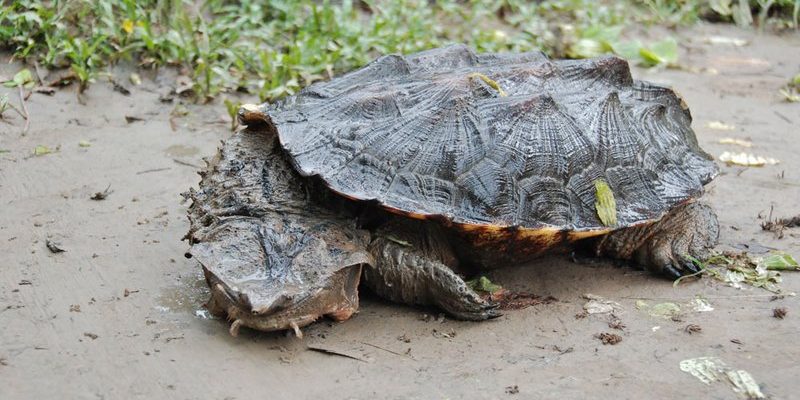
The Matamata Turtle is one of nature’s most fascinating creatures. With a body shape and texture that mimic the environment it inhabits, this turtle is like a master of hide-and-seek. Imagine a creature so well-camouflaged that its very existence feels like a riddle waiting to be solved. Found primarily in the quiet waters of South America, the Matamata Turtle is less of a conventional turtle and more of an aquatic enigma.
You might be wondering why this turtle looks so different from its relatives. Its specialized body structure is designed for survival in murky waters where visibility is low. With a flat, triangular head and a shell covered in algae and moss, it blends seamlessly into its surroundings. This unique adaptation not only helps it avoid predators, but it also makes it an effective hunter, as it can ambush unsuspecting prey. Let’s dive deeper into what makes the Matamata Turtle so special.
Physical Characteristics
The Matamata Turtle boasts a range of remarkable physical traits that make it stand out. First and foremost, its shell is quite distinct. Unlike the smooth, streamlined shells of many turtles, the Matamata’s shell is flat and has an irregular shape, often resembling a pile of leaves or a piece of bark. This helps it blend in with its habitat, which is typically filled with floating debris. The overall coloration is usually a mottled brown or greenish hue, enhancing its camouflage even further.
Its head is another striking feature. It’s long and flattened, allowing the turtle to dart its head remarkably quickly. This adaptation is essential not just for feeding but also for avoiding threats. When hunting fish, the Matamata Turtle can expand its throat dramatically, creating a vacuum that sucks in water and captures its prey. Imagine the surprise of a small fish when it finds itself suddenly swallowed by what it thought was a pile of leaves!
Size and Weight
In terms of size, Matamata Turtles can reach up to 18 inches in length, although most are closer to 12 to 16 inches. They’re relatively hefty for a turtle; adults can weigh anywhere from 15 to 40 pounds. This size gives them a robust presence in the water, making them less susceptible to smaller predatory fish. Size also plays a significant role in their breeding habits; larger females tend to produce more eggs than their smaller counterparts, ensuring the continuation of their species.
Habitat and Distribution
The Matamata Turtle is native to the slow-moving rivers, streams, and swamps of the Amazon Basin in South America. These areas are characterized by dense, lush vegetation and plenty of submerged debris, providing the perfect environment for these turtles to thrive. The water here is often tinted brown due to the decaying plant material, making it easier for the Matamata to remain hidden.
In terms of geographical distribution, the turtle is primarily found in countries like Brazil, Colombia, and parts of Venezuela. This specific habitat preference is a double-edged sword. While the Matamata Turtle has evolved to thrive in such environments, it also makes them vulnerable to habitat destruction. Deforestation and pollution are major threats that could affect their populations.
Behavior and Diet
When it comes to behavior, the Matamata Turtle is quite solitary. They’re not social animals and prefer to spend their time submerged, either resting or hunting. As ambush predators, they rely heavily on their stealth to capture their prey. Their diet mainly consists of small fish and invertebrates, which they hunt using a sudden, swift motion to create a vacuum effect. This unique feeding technique is not only fascinating but also essential for their survival.
Reproduction and Lifespan
Reproduction in Matamata Turtles typically occurs during the warmer months. Females can lay around 10 to 30 eggs at a time in sandy nests near the water’s edge. Once the eggs are laid, they incubate for about 90 days before hatching. The hatchlings are incredibly small and immediately face a host of dangers, from predators to environmental hazards.
As for lifespan, Matamata Turtles can live for several decades in the wild, with some estimates suggesting they can reach up to 50 years under optimal conditions. This long lifespan is somewhat common among turtles, allowing them time to reproduce and contribute to the population over many years. However, in captivity, factors like diet, habitat conditions, and care can influence their longevity.
Conservation Status
Currently, the Matamata Turtle is not classified as endangered, but it does face threats that could impact its future. Habitat loss due to deforestation and pollution poses significant risks to their populations. Moreover, they are often caught for the pet trade, which can lead to declines in local populations. Conservation efforts are crucial to ensure that these turtles continue to inhabit the rivers and swamps of South America.
Organizations focused on wildlife conservation work to raise awareness about the importance of preserving natural habitats. By protecting these ecosystems, we not only help the Matamata Turtle but countless other species that share their habitat. Efforts may include establishing protected areas, promoting sustainable practices, and educating local communities about the value of biodiversity.
Interesting Facts About the Matamata Turtle
There are plenty of intriguing facts about the Matamata Turtle that may surprise you. For one, they can hold their breath for an extended period, often remaining submerged for up to 16 hours. This adaptation allows them to avoid predators and ambush prey without needing to surface for air frequently.
Another fun fact is that they have a unique way of swimming. Unlike many turtles that use their flippers for propulsion, Matamata Turtles tend to move through the water using subtle movements of their legs and head, giving them a more serpentine appearance. This method helps them remain stealthy as they hunt.
Matamata Turtle Facts at a Glance
| Scientific Name: | Chelydrodes macquariei |
| Size: | 12 to 18 inches |
| Weight: | 15 to 40 pounds |
| Habitat: | Slow-moving rivers and swamps |
| Diet: | Small fish and invertebrates |
| Life Span: | Up to 50 years |
FAQ
What do Matamata Turtles eat?
Matamata Turtles primarily feast on small fish and occasionally invertebrates. They are ambush predators, waiting patiently for their prey to come close before executing a swift capture using their unique vacuum feeding method. This adaptation makes them highly effective hunters in their natural habitats.
Are Matamata Turtles good pets?
While Matamata Turtles are fascinating creatures, they are not recommended as pets for beginners. Their specific habitat and dietary needs can be challenging to replicate in captivity. Additionally, they require a significant amount of space and clean water to thrive. If you’re contemplating a turtle as a pet, consider more common species that are easier to care for.
How long can Matamata Turtles hold their breath?
Matamata Turtles are impressively adapted for life underwater, often capable of holding their breath for up to 16 hours. This ability allows them to remain submerged for extended periods, helping them to both hunt for food and avoid predators.
Where can I find Matamata Turtles in the wild?
These intriguing turtles are primarily found in the Amazon Basin, encompassing areas of Brazil, Colombia, and Venezuela. They inhabit slow-moving rivers, streams, and swampy regions, where they can easily blend into their surroundings and hunt effectively.
What threats do Matamata Turtles face?
Currently, Matamata Turtles face several threats, including habitat loss due to deforestation and pollution. They are also sometimes collected for the pet trade, which can affect local populations. Conservation efforts are crucial to ensure their survival in the wild.
Can you tell me about their breeding habits?
Matamata Turtles breed during warmer months, with females capable of laying 10 to 30 eggs in sandy nests near water. After an incubation period of around 90 days, hatchlings emerge, facing numerous challenges in their early life stages. This reproductive strategy helps maintain their populations in the wild.
How can we help conserve Matamata Turtles?
Conserving Matamata Turtles involves preserving their natural habitats and raising awareness about their ecological importance. Supporting organizations committed to wildlife conservation and promoting sustainable practices can help protect these turtles and their environments. You can also educate others about the threats they face and the importance of biodiversity.
What’s the best way to observe Matamata Turtles?
To observe Matamata Turtles in their natural habitat, consider eco-tourism options that focus on responsible wildlife viewing. Guided tours in the Amazon Basin can provide opportunities to see these turtles in the wild. Before going, make sure the tour operators prioritize conservation and respect for wildlife habitats.
Do Matamata Turtles have any natural predators?
Yes, adult Matamata Turtles are relatively safe due to their size and disguise, but they can still fall prey to larger predators, such as caimans and jaguars. Hatchlings, on the other hand, are more vulnerable and face threats from various fish, birds, and other predators until they reach maturity.
What unique adaptations do Matamata Turtles have?
One of the most remarkable adaptations of the Matamata Turtle is its ability to create a vacuum to capture prey. Additionally, its flattened shape and rough shell allow it to blend seamlessly with its environment, helping it avoid detection by both prey and predators. These adaptations make it an incredible example of nature’s ingenuity.
Are Matamata Turtles social animals?
No, Matamata Turtles are solitary creatures. They prefer to hunt and live alone, often spending extended periods submerged to avoid attracting attention. This solitary nature contributes to their efficient hunting strategies and helps them avoid competition for food.
Can Matamata Turtles live in aquariums?
While they can be kept in aquariums, Matamata Turtles require a very specific environment that can be challenging to replicate in a home setting. They need ample space, clean water, and specific water temperatures. Prospective owners should thoroughly research their care needs before considering them as pets.

